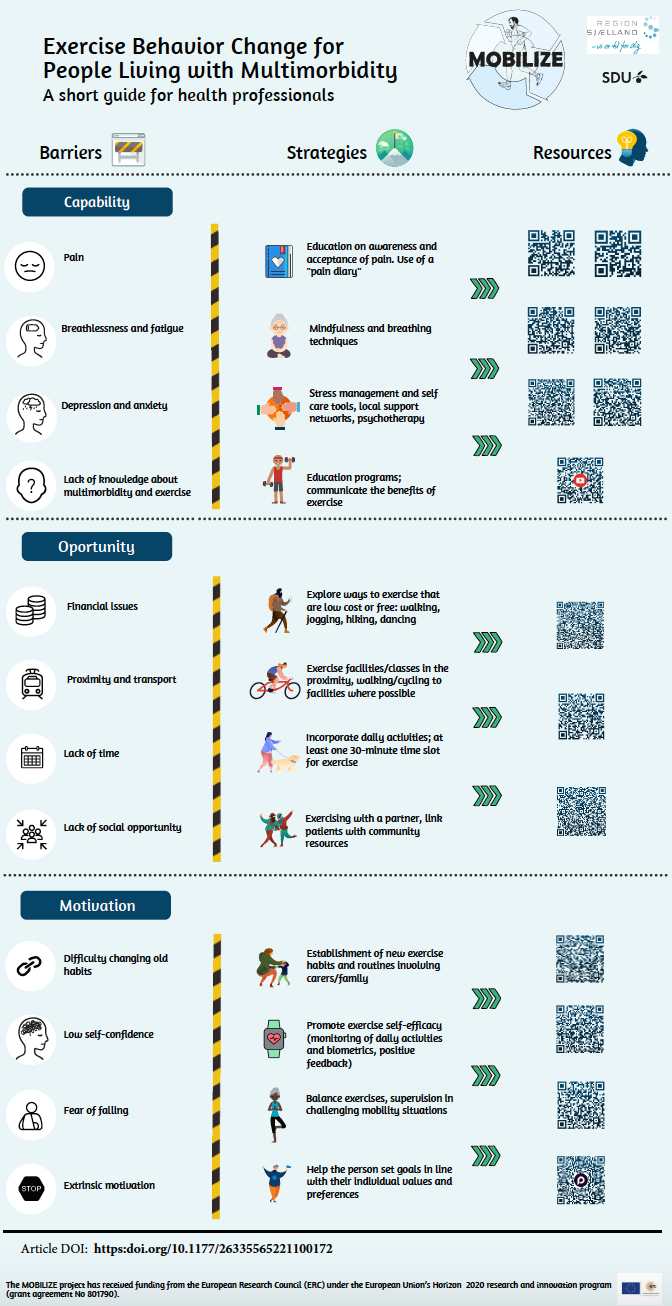Exercise behaviour change- A complex issue
Exercise is critical for successful self-management in people with multimorbidity, however, we know little about people’s needs, experiences and preferences. Lifestyle changes—including an increase in physical activity via exercise or exercise therapy limit disease progression, reduce medication need, and personal and societal costs 11-13. Despite the wide range of health benefits of exercise in multimorbid people 15-18 common barriers like pain, fatigue, financial constraints, isolation, often prevent engagement 19. Understanding exercise behaviour in this population is necessary if we want to design effective and efficient behavioural interventions 21,22.
Putting the pieces together – Common understandings and unique challenges 
With our study, we aimed to qualitatively explore the perspectives of people living with multimorbidity, healthcare professionals, relatives, and patient advocates in relation to self-management and exercise behaviour particularly. To do this, we utilised a hybrid inductive-deductive approach using Framework Analysis that enabled the subsequent use of the COM-B model in relation to the study of exercise behaviour. We conducted 17 interviews (9 focus groups; 8 key informants) with 48 informants from four groups (22 people living with multimorbidity, 17 healthcare professionals, 5 relatives, and 5 patient advocates). We constructed three themes: Patient education, supporting behaviour change, and lack of a ‘burning platform’ (lack of urgency in addressing multimorbidity). The application of the COM-B profile unveiled a variety of barriers to exercise and self-management support (pain, fatigue, breathlessness, lack of motivation, financial issues, accessibility, decreased social support). Most groups acknowledged the importance of disease knowledge and social support while being aware of the multiple barriers to behaviour change. Healthcare professionals aimed to find ways of motivating their patients and supporting them in changing unhealthy habits with the available resources that were rather limited; relatives were uncertain about their role in helping their loved ones self-manage and often took over responsibilities; patient advocates found themselves competing for funding and struggling to provide services and advocacy with the re-sources that are available to them.
Short guide for healthcare professionals
Having identified many of the barriers to exercise that people with multimorbidity commonly experience, we put together a short guide for healthcare professionals that provides some practical strategies and resources to help people overcome these barriers (e.g., for those who lack social opportunity encourage exercising with a partner, and/or link them with existing community resources and programs).
Competing interests
The author(s) declared the following potential conflicts of interest with respect to the research, authorship, and/or publication of this article: Dr. Skou is co-founder of Good Life with Osteoarthritis in Denmark (GLA:D®), a not-for profit initiative hosted at University of Southern Denmark aimed at implementing clinical guidelines for osteoarthritis in clinical practice. The authors declare that they do not have other significant competing financial, professional, or personal interests that might have
influenced the performance or presentation of the work described in this manuscript.
Funding
The author(s) disclosed receipt of the following financial support for the research, authorship, and/or publication of this article: This work was supported by the European Research Council (ERC) under the European Union’s Horizon 2020 research and innovation program; MOBILIZE (grant agreement No 801790), The Danish Regions and The Danish Health Confederation Development and Research Fund (project nr. 2703).
Authors and Affiiations:
Madalina Jäger 1,2, Mathias Constantin Lindhardt 1, Julie Rønne Pedersen 1, Mette Dideriksen 1,2, Mette Nyberg 2, Alessio Bricca 1,2, Uffe Bodtger 3,4, Dimitra Vasiliki Pouliopoulou 1, Julie Midtgaard 5,6 and Søren T. Skou 1,2
1Department of Sports Science and Clinical Biomechanics, University of Southern Denmark, Odense M, Denmark
2Department of Physiotherapy and Occupational Therapy, Næstved-Slagelse-Ringsted Hospitals, Region Zealand, Slagelse, Denmark
3Department of Respiratory Medicine, Zealand University Hospital Næstved, Næstved, Denmark
4Institute for Regional Heath Research, University of Southern Denmark, Odense M, Denmark
5Department of Clinical Medicine, University of Copenhagen, Copenhagen, Denmark
6Mental Health Services in the Capital Region of Denmark, Mental Health Centre Glostrup, University of Copenhagen, Copenhagen, Denmark
References
11 Morris RL, Sanders C, Kennedy AP, et al. Shifting priorities in multimorbidity: a longitudinal qualitative study of patient’s prioritization of multiple conditions. Chronic Illness 2011; 7(2): 147–161.
12 Townsend A. Applying Bourdieu’s theory to accounts of living with multimorbidity. Chronic Illness 2012; 8(2):89–101.
13 Coventry PA, Hudson JL, Kontopantelis E, et al. Characteristics of effective collaborative care for treatment of depression: a systematic review and meta-regression of 74 randomised controlled trials. PLoS One 2014; 9(9): e108114.
15 Pasanen T, Tolvanen S, Heinonen A, et al. Exercise therapy for functional capacity in chronic diseases: an overview of meta-analyses of randomised controlled trials. British Journal of Sports Medicine 2017; 51(20): 1459–1465.
16 de Rooij M, van der Leeden M, Cheung J, et al. Efficacy of tailored exercise therapy on physical functioning in patients with knee osteoarthritis and comorbidity: a randomized controlled trial. Arthritis Care & Research 2017; 69(6): 807–816.
17 de Vries NM, van Ravensberg CD, Hobbelen JSM, et al. Effects of physical exercise therapy on mobility, physical functioning, physical activity and quality of life in community-dwelling older adults with impaired mobility, physical disability and/or multi-morbidity: a meta-analysis. Ageing Research Reviews 2012; 11(1): 136–149.
18 Bricca A, Harris LK, J¨ager M, et al. Benefits and harms of exercise therapy in people with multimorbidity: a systematic review and meta-analysis of randomised controlled trials. Ageing Research Reviews 2020; 63: 101166.
19 Holden MA, Nicholls EE, Young J, et al. Role of exercise for knee pain: what do older adults in the community think? Arthritis Care & Research 2012; 64(10): 1554–1564.
20 Dekker J, Buurman BM and van der Leeden M. Exercise inpeople with comorbidity or multimorbidity. Health Psychology 2019; 38(9): 822–830.
21 Michie S, West R, Campbell R, et al. ABC of behaviour change theories. Silverback publishing, 2014.
22 Davis R, Campbell R, Hildon Z, et al. Theories of behaviour and behaviour change across the social and behavioural sciences: a scoping review. Health Psychology Review 2015; (3): 323–344.